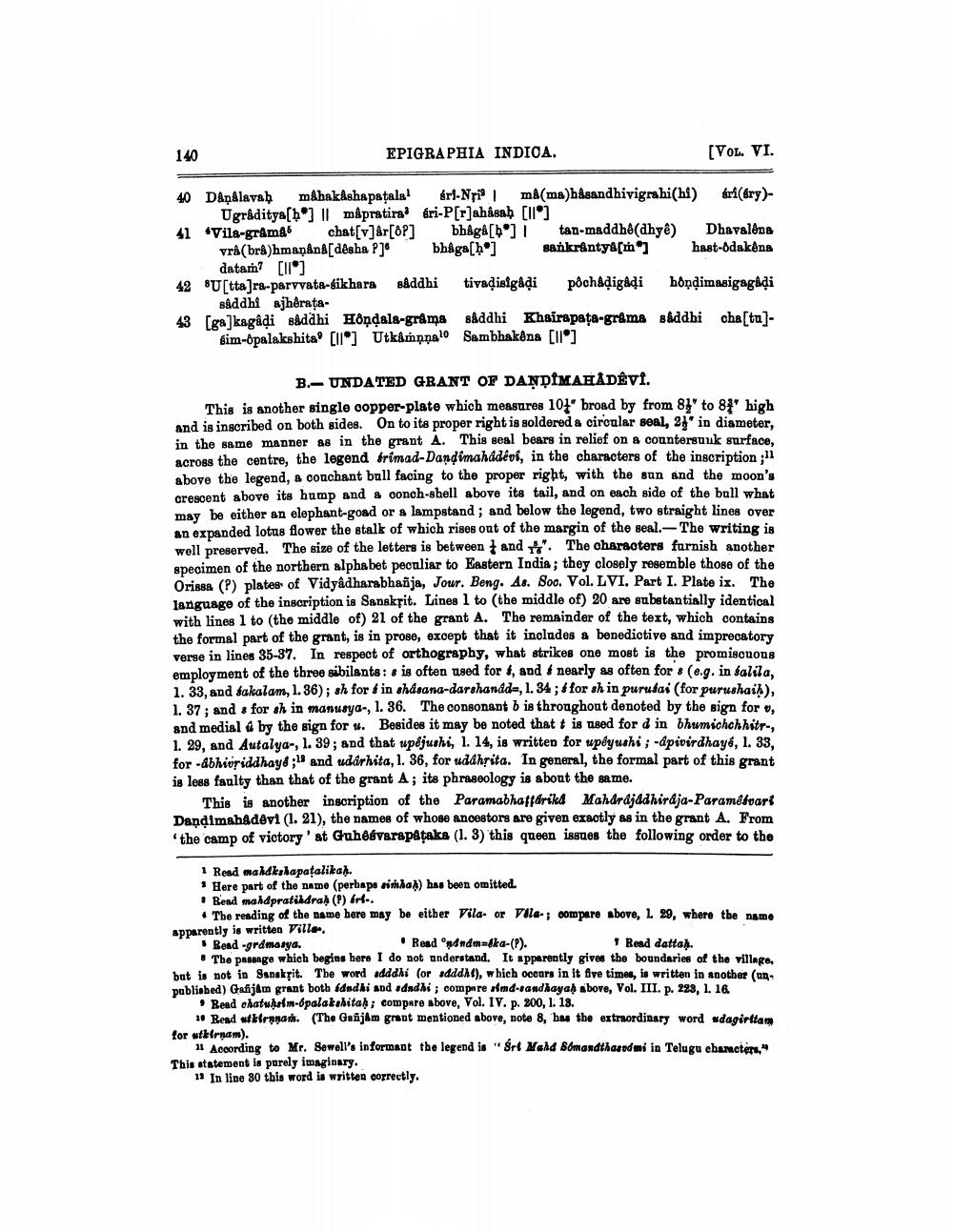________________
140
EPIGRAPHIA INDICA.
40 Dân&lavah mahakâshapatala śri-Nri må(ma)hasandhivigrahi(hi) Ugråditya[b] måpratira éri-P[r]ahasab [II]
41 Vila-grâmâ chat[v][6] bhg[b] | tan-maddhê (dhyê) vrâ(bra)hmanânâ[dêsha ?] bhaga[b] sankrantyâ[m]
datam? [II]
42 U[tta]ra-parvvata-sikhara såddhi
pôchâḍigâḍi
delay)
Dhavalêna hast-ôdakéna
tivaḍisigâḍi
hôṇḍimasigagâḍi
såddhi ajhêrata
43 [ga]kagâḍi såddhi Honḍala-grama såddhi Khairapata-grama såddhi cha[tu]sim-opalakshita [1] Utkâmppalo Sambhakêna [11]
[VOL. VI.
B.- UNDATED GRANT OF DANDIMAHADEVÎ.
This is another single copper-plate which measures 101" broad by from 83" to 8" high and is inscribed on both sides. On to its proper right is soldered a circular seal, 23" in diameter, in the same manner as in the grant A. This seal bears in relief on a countersunk surface, across the centre, the legend frimad-Dandimahadevi, in the characters of the inscription;11 above the legend, a couchant bull facing to the proper right, with the sun and the moon's crescent above its hump and a conch-shell above its tail, and on each side of the bull what may be either an elephant-goad or a lampstand; and below the legend, two straight lines over an expanded lotus flower the stalk of which rises out of the margin of the seal.-The writing is well preserved. The size of the letters is between and ". The characters furnish another specimen of the northern alphabet peculiar to Eastern India; they closely resemble those of the Orissa (P) plates of Vidyadharabhañja, Jour. Beng. As. Soc. Vol. LVI. Part I. Plate ix. The language of the inscription is Sanskrit. Lines 1 to (the middle of) 20 are substantially identical with lines 1 to (the middle of) 21 of the grant A. The remainder of the text, which contains the formal part of the grant, is in prose, except that it includes a benedictive and imprecatory verse in lines 35-37. In respect of orthography, what strikes one most is the promiscuous employment of the three sibilants: s is often used for &, and nearly as often for s (e.g. in salila, 1. 33, and sakalam, 1.36); sh for f in shasana-darshandd, 1. 34 ; & for sh in purusas (for purushaih), 1. 37; and s for sh in manusya-, 1. 36. The consonant b is throughout denoted by the sign for v, and medial û by the sign for u. Besides it may be noted that t is used for d in bhumichchhitr-, 1. 29, and Autalya-, 1. 39; and that upejushi, 1. 14, is written for upêyushi; -ápivirdhayé, 1. 33, for-abhivriddhay8;18 and udárhita, 1. 36, for uddhṛita. In general, the formal part of this grant is less faulty than that of the grant A; its phraseology is about the same.
This is another inscription of the Paramabhattárika Mahárájádhirája-Paramêtvari Daṇḍimahadevi (1. 21), the names of whose ancestors are given exactly as in the grant A. From 'the camp of victory' at Guhéévarapaṭaka (1. 3) this queen issues the following order to the
1 Read mahdkshapatalikah.
Here part of the name (perhaps simhaд) has been omitted.
Read mahdpratikdrah (P) irl-.
The reading of the name here may be either Vila- or Véla-; compare above, 1. 29, where the name apparently is written Villa,
Read Andmeka-(?).
Read dattaḥ.
• Bead -gramasya. The passage which begins here I do not understand. It apparently gives the boundaries of the village, but is not in Sanskrit. The word adddhi (or adddht), which occurs in it five times, is written in another (unpublished) Gañjam grant both fdndhi and sandhi; compare simd-sandhayaḥ above, Vol. III. p. 223, 1. 16.
Read chatuheim-6palakshitaḥ; compare above, Vol. IV. p. 200, 1. 18.
10 Bead atkirnṇam. (The Gañjam grant mentioned above, note 8, has the extraordinary word wdagirttam for utkirṇam).
11 According to Mr. Sewell's informant the legend is "Srt Mahd Somandthasedmi in Telugu characters," This statement is purely imaginary.
13 In line 30 this word is written correctly.




